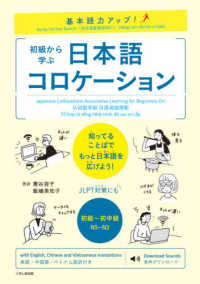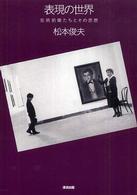- ホーム
- > 洋書
- > 英文書
- > Computer / Desktop Publishing
Full Description
&>The Start-to-Finish, Best-Practice Guide to Implementing and Using DITA Darwin Information Typing Architecture (DITA) is today's most powerful toolbox for constructing information. By implementing DITA, organizations can gain more value from their technical documentation than ever before. Now, three DITA pioneers offer the first complete roadmap for successful DITA adoption, implementation, and usage. Drawing on years of experience helping large organizations adopt DITA, the authors answer crucial questions the "official" DITA documents ignore, including: Where do you start? What should you know up front? What are the pitfalls in implementing DITA? How can you avoid those pitfalls?The authors begin with topic-based writing, presenting proven best practices for developing effective topics and short descriptions. Next, they address content architecture, including how best to set up and implement DITA maps, linking strategies, metadata, conditional processing, and content reuse. Finally, they offer "in the trenches" solutions for ensuring quality implementations, including guidance on content conversion. Coverage includes: Knowing how and when to use each DITA element-and when not to Writing "minimalist," task-oriented information that quickly meets users' needs Creating effective task, concept, and reference topics for any product, technology, or service Writing effective short descriptions that work well in all contexts Structuring DITA maps to bind topics together and provide superior navigation Using links to create information webs that improve retrievability and navigation Gaining benefits from metadata without getting lost in complexity Using conditional processing to eliminate redundancy and rework Systematically promoting reuse to improve quality and reduce costs Planning, resourcing, and executing effective content conversion Improving quality by editing DITA content and XML markup If you're a writer, editor, information architect, manager, or consultant who evaluates, deploys, or uses DITA, this book will guide you all the way to success. Also see the other books in this IBM Press series:Developing Quality Technical Information: A Handbook for Writers and Editors The IBM Style Guide: Conventions for Writers and Editors
Contents
Acknowledgments xviiiAbout the Authors xxIntroduction 1Chapter 1 Topic-Based Writing in DITA 7Books, Topics, and Webs of Information 7Advantages of Writing in Topics for Writing Teams 9Writers Can Work More Productively 9Writers Can Share Content with Other Writers 9Writers Can Reuse Topics 10Writers Can More Quickly Organize or Reorganize Content 10Reviewers Can Review Small Groups of Topics Instead of Long Books 10DITA Topic Types 10Task Orientation 12Task Analysis 13Minimalist Writing 16Know Your Audience 16Remove Nonessential Content 16Focus on User Goals, Not Product Functions 16To Wrap Up 17Topic-Based Writing Checklist 18Task analysis form 19Chapter 2 Task Topics 21Separate Task Information from Conceptual or Reference Information 22Write One Procedure per Topic 22Create Subtasks to Organize Long Procedures 22Task Components and DITA Elements 23Titling the Task:








